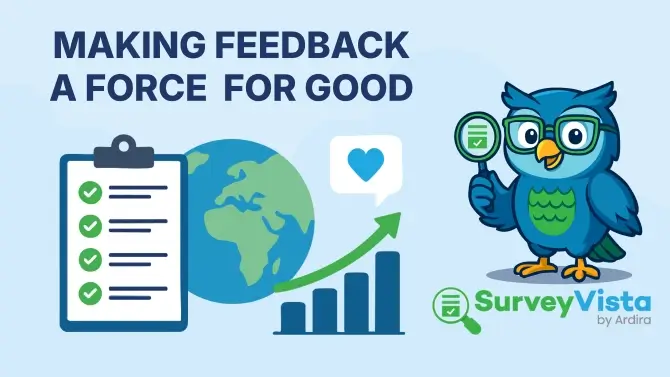Your survey data is sitting there, waiting to tell its story. But raw numbers and scattered responses won’t magically transform into business insights. You need a survey report that bridges the gap between what customers said and what your team should do next.
The difference between a good survey report and a great one isn’t just prettier charts or longer explanations. It’s about creating a document that sparks immediate action and drives real change in your organization.
What is a Survey Report?
A survey report organizes data you’ve collected, integrates it with valuable context, helps your team understand what’s really happening, and points the way to what you should do next.
When your survey report closes this loop, it turns scattered responses into a powerful roadmap for change.
What Makes a Survey Report Worth Reading
A survey report should answer the “so what?” question before anyone has to ask it. Your stakeholders don’t have time to decode data—they need clear direction on what to do next.
How to Create a Survey Analysis Report
Executive Summary That Actually Summarizes
Your executive summary isn’t just a preview—it’s often the only section busy executives will read. Lead with your most important finding, not your methodology. Include specific numbers that matter to business outcomes.
Methodology Section That Builds Trust
Transparency builds credibility, especially when your findings challenge existing assumptions. Include your sample size, response rate, and collection timeframe upfront. Address potential limitations honestly.
If your response rate was lower than expected or certain demographics are underrepresented, acknowledge it and explain how it might affect your conclusions. Keep methodology details concise but complete.
Data Visualization That Tells Stories
Charts and graphs should simplify complex information, not complicate it. Each visual element should support a specific point you’re making in your narrative. Use consistent colors and formatting throughout your report.
Include context for your numbers. A 15% negative feedback rate means more when readers know it’s down from 23% previously.
Detailed Findings With Context
Present your quantitative data first, then layer in qualitative insights that explain the numbers. If satisfaction dropped in a specific area, include customer quotes that reveal why. Segment your findings by relevant demographics or customer types.
Connect findings to business impact whenever possible. Don’t just report that mobile app complaints increased—explain how that affects customer retention or support ticket volume.
Actionable Recommendations
Your recommendations section should read like a project plan, not a wish list. Include specific actions, responsible teams, and suggested timelines. Prioritize recommendations based on impact and feasibility.
Link each recommendation back to specific findings in your report. This connection helps stakeholders understand why each action matters.
How to Handle Different Types of Survey Data
Making Sense of Quantitative Responses
Numbers tell you what happened, but they don’t always explain why. Look for patterns across different question types and respondent segments. Pay attention to response distributions, not just averages.
If your average satisfaction score is 4.2 out of 5, but responses cluster at both extremes, you have a different story than if most responses hover around 4. Use statistical significance testing when comparing groups or time periods.
Extracting Insights From Open-Ended Feedback
Qualitative responses reveal the emotions and specific experiences behind your quantitative data. Look for recurring themes that appear across multiple responses. Categorize open-ended feedback into actionable themes.
Instead of just noting “app issues,” specify whether customers struggle with login, navigation, or specific features. Include representative quotes that illustrate broader patterns rather than isolated complaints.
Combining Multiple Data Sources
Your survey data becomes more powerful when combined with other customer information. Connect survey responses to customer behavior, support tickets, or purchase history when possible. Look for contradictions between what customers say and what they do.
Use multiple data sources to validate your survey findings. If customers report improved satisfaction, does that align with reduced churn or increased referrals?
Top Tips for Creating an Effective Survey Analysis Report
You’ve got the scoop on what makes a survey analysis report spark real impact—and how to build one from scratch. Here are some tips to keep your survey analysis report impactful.
- Collect feedback at the right moments.
Focus your surveys on key touchpoints that matter most to your business—this ensures the data you gather is meaningful and actionable. - Keep data where it belongs.
With SurveyVista’s 100 % Salesforce-native approach, your responses are automatically integrated—no APIs, no code, and no sync delays. Everything happens where it should—inside Salesforce. - Use clear, real-time dashboards.
Make analysis easy with visual dashboards and simple charts, so trends and outliers stand out at a glance. Don’t let insights get buried in complexity—clarity wins every time. - Spot root causes, not just symptoms.
Go beyond the surface by tying feedback to specific records in Salesforce. This lets you see the “why” behind the numbers so you can prioritize what matters most. - Share insights with a plan for action.
Don’t just report—recommend. Every survey report should close the loop: Collect → Integrate → Understand → Act, so your team knows exactly what to do next. - Act quickly to drive real change.
The faster you move from insight to action, the sooner you boost satisfaction, loyalty, and growth. Collect feedback at noon, act on it by one.
Turning Survey Data Into Customer-Centric Growth
The best survey reports don’t just document what customers think—they catalyze organizational change that improves customer experiences. Your role extends beyond data collection and reporting to helping your organization act on customer insights.
Remember that survey reporting is an ongoing process, not a one-time deliverable. Each report should build on previous findings and track progress toward customer experience goals. When your survey reports consistently drive meaningful action, they become essential tools for customer-centric growth rather than just compliance documents that satisfy research requirements.
Frequently Asked Questions
How long should a survey report be?
Focus on quality over length. Most effective survey reports are 5-15 pages, including an executive summary, key findings, and actionable recommendations. Your audience’s attention span matters more than hitting a specific page count.
What’s the difference between survey results and survey insights?
Results show you what happened—like satisfaction scores or response rates. Insights explain why it happened and what you should do about it. Great survey reports transform raw results into actionable business insights.
How often should I create survey reports?
It depends on your survey frequency and business needs. Monthly reports work well for ongoing feedback programs, while quarterly reports suit periodic surveys. The key is maintaining consistency so stakeholders know when to expect updates.
Should I include all survey questions in my report?
No. Focus on findings that connect to business objectives or reveal unexpected insights. Save detailed breakdowns for appendices or follow-up analysis. Your main report should highlight what matters most to decision-makers.
How do I make survey reports more engaging for busy executives?
Lead with business impact, not methodology. Use clear visuals, include specific next steps, and connect findings to business priorities. Make your executive summary comprehensive enough to stand alone if needed.
More Like This

Rajesh Unadkat 
Founder and CEO
Rajesh is the visionary leader at the helm of SurveyVista. With a profound vision for the transformative potential of survey solutions, he founded the company in 2020. Rajesh's unwavering commitment to harnessing the power of data-driven insights has led to SurveyVista's rapid evolution as an industry leader.
Connect with Rajesh on LinkedIn to stay updated on the latest insights into the world of survey solutions for customer and employee experience management.



